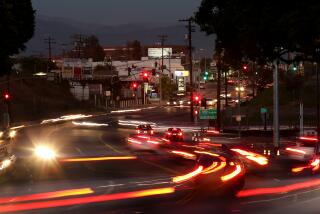Town Fears Highway Move Could Drive It Off the Map
- Share via
TROY, Kan. — Highway 7 winds into Troy with less than a foot of gravel between the pavement and the ditch and only a handful of farmhouse windows to light the curves.
Few deny that it’s a dangerous stretch of road.
But a $10.5-million plan to move it two miles west has the little town ready to march on Big Government.
“When you take a highway out of a little town, you don’t have much left,” Mayor Leonard Clary said. “Look at what happened on old Route 66--all those small towns just dried up and dropped off the vine.”
As soon as the state’s plan to move Highway 7 was released, Clary started a petition to stop it. Within 10 days, more than one-quarter of Troy’s 1,100 people had stopped by the town hall to sign it.
Troy knows all about the consequences of moving a highway. A decade ago, Highway 36 and its traffic were rerouted away from the center of town and all its businesses.
Highway 36 put Troy right in front of travelers’ eyes. The tower of the historic courthouse drew cars down Troy’s brick streets to antique stores like Heart and Soul Collectibles, always filled this time of year with memories of Christmases past, and restaurants like Sheila’s that lit up the square.
It was an oasis in an empty stretch running for 60 miles west of St. Joseph, Mo.--until the highway was moved north of town and Troy was sliced out of the picture, Clary said.
Many of those stores have gone dark since U.S. 36 was moved. Now the Highway 7 plan threatens to hack Troy off from the rest of the world for good, he said.
State engineers have determined that straightening Highway 7 is the best of four options, but it isn’t a done deal yet, said Marty Mathews, a spokesman for the Kansas Department of Transportation.
The plan has high priority, and the survey work is underway as part of a $12.3-billion, eight-year road improvement plan proposed by the state. The plan is expected to go before the legislature early this year.
“Good Lord willing and the creeks don’t rise, it is likely to happen in a decade,” Mathews said of the Highway 7 rerouting. “But there are so many other issues that can come up to push a project up or back.”
Clary would prefer to see the existing road widened, but that wouldn’t be simple.
The old Mount Olive Cemetery squeezes the highway from both sides about a mile south of town, and no one wants to move graves. Routing the highway around the cemetery would cut through homes or farmland.
“You can’t satisfy everyone,” Clary said. “But I think moving Highway 7 out of town would have the worst effect.
“If your businesses aren’t right there by the offramp, the cars don’t stop.”
No one knows that better than Debbie Simpson.
Her “Troy Fast Lane” gas station, which pulled in hundreds of drivers a day when U.S. 36 passed by its front door, is now out of sight of the new highway.
“I had double the help and probably four times the traffic before they finished 36. Then . . . it all came to a screeching halt,” Simpson said.
Her small convenience store can’t afford a highway billboard, and the business district sign put up on Highway 36 is too small to catch the eye in time for a driver to turn.
“Troy’s really good to us, and we get a lot of local traffic here and across the street at Amoco, but there aren’t enough people here,” she said.
County Commissioner Arlene Robinson supports Clary’s efforts but isn’t optimistic. Still, she isn’t about to let the state off the hook.
It should at least compromise and turn the existing stretch into a well-marked business route so travelers know that the restaurants, gas stations and stores are there, she said.
“Moving the highway may look good on paper, but they aren’t seeing the economic impact,” she said. “They don’t realize how this sort of move impacts the whole region. We don’t want Troy to dry up and be a ghost town.”
More to Read
Sign up for Essential California
The most important California stories and recommendations in your inbox every morning.
You may occasionally receive promotional content from the Los Angeles Times.













